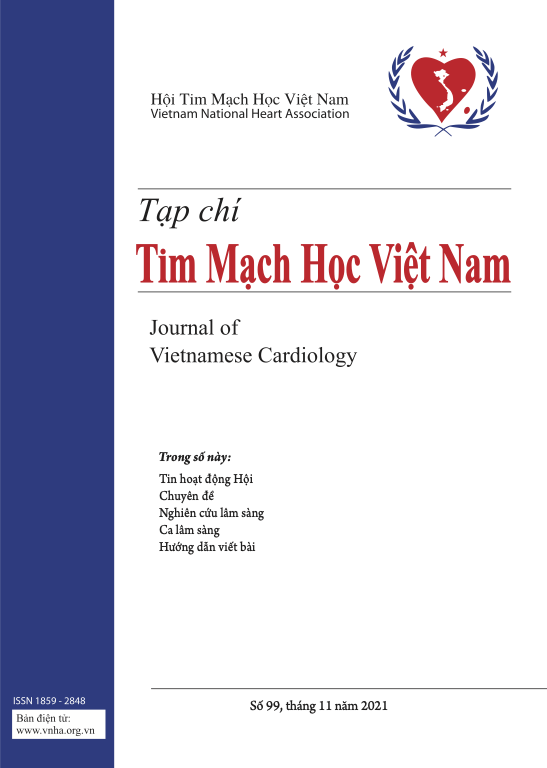Đánh giá hiệu quả trong can thiệp động mạch vành của stent phủ thuốc không polymer
Tóm tắt
Stent phủ thuốc không polymer giảm thiểu thời gian dùng kháng ngưng tập tiểu cầu kép mà vẫn có khả năng chống tái hẹp cao trong can thiệp bệnh động mạch vành.
Phương pháp nghiên cứu: phỏng thực nghiệm trên 72 bệnh nhân được đặt stent phủ thuốc không polymer BioFreedom tại Viện Tim mạch Việt Nam từ tháng 9/2015 đến 9/2017.
Kết quả: Có tổng số 101 stent được đặt, tỷ lệ stent/bệnh nhân là 1.4/1. Tỷ lệ đau thắt ngực ổn định/đau ngực không ổn định/nhồi máu cơ tim là 30.6%/33.3%/36.1%. Phần trăm hẹp động mạch vành trung bình là 82.56 ± 9.04%. Tỷ lệ thành công về mặt kỹ thuật là 97.2%, về thủ thuật là 100%. Có 4 bệnh nhân (5,6%) gặp biến cố tim mạch chính trong thời gian theo dõi trung bình là 550.5 ± 89.3 ngày, 21 bệnh nhân (29.2%) được chụp lại động mạch vành sau tối thiểu 12 tháng thì có 1 trường hợp (4.8%) tái hẹp có ý nghĩa trong stent.
Kết luận: Stent phủ thuốc không polymer BioFreedom an toàn và hiệu quả trong can thiệp động mạch vành.
Từ khoá: Stent phủ thuốc không polymer, động mạch vành, can thiệp qua da.
Tài liệu tham khảo
1. Colombo A, Drzewiecki J, Banning A, et al. (2003), Randomized study to assess the effectiveness of slow and moderate-release polymer-based paclitaxel-eluting stents for coronary artery lesions. Circulation, 108, 788-794.
![]()
2. Steg PG, Huber K, Andreotti F, et al (2011). Bleeding in acute coronary syndromes and percutaneous coronary interventions: position paper by the Working Group on Thrombosis of the European Society of Cardiology. Eur Heart J, 32, 1854-64.
![]()
3. Levine GN, Bates ER, Blankenship JC, et al. (2011). ACCF/AHA/SCAI Guideline for Percutaneous Coronary Intervention: a report of the American College of Cardiology Foundation/American Heart Association Task Force on Practice Guidelines and the Society for Cardiovascular Angiography and Interventions. Circulation, 124, 574-651.
![]()
4. Wenaweser P, Daemen J, Zwahlen M, et al (2008). Incidence and correlates of drug-eluting stent thrombosis in routine clinical practice. 4-year results from a large 2-institutional cohort study. J Am Coll Cardiol, 52, 1134-40
![]()
5. Philip Urban, Alex Abizaid, et at (2013). Rationale and design of the LEADERS FREE trial: A randomized double-blind comparison of the BioFreedom drug-coated stent vs the Gazelle bare metal stent in patients at high bleeding risk using a short (1 month) course of dual antiplatelet therapy. Am Heart J, 165, 704-9.
![]()
6. Urban P, Meredith IT, et al (2015). Polymer-free Drug-Coated Coronary Stents in Patients at High Bleeding Risk. N Engl J Med, 373(21):2038.
![]()
7. Wijns W, Kolh P, Danchin N, et al (2010). Guidelines on myocardial revascularization. The Task Force on Myocardial revascularization of the European Society of Cardiology (ESC and the European Association for Cardio-Thoracic Surgery (EACTS). Eur Heart J, 31, 2501-55.
![]()
8. Moohammad A, Vahideh S, et al (2016). A One-Year Outcome of Everolimus-Eluting Stents Versus Biolimus-Eluting Stents in Patients Undergoing Percutaneous Coronary Intervention. J Tehran Heart Cent, 11(2): 62-67.
![]()
9. Robert A, Micheal J, et al (2016). Stent thrombosis and restenosis: what have we learned and where are we going? Eur Heart J, 36 (47): 3320-3331.
![]()








